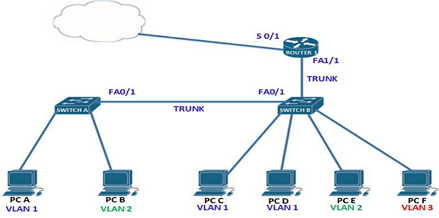For today’s Cisco Certified Entry Network Technician (CCENT) and Cisco Certified Network Associate (CCNA) exam question topic today we will be covering Inter-VLAN Routing and how it works. The topic is not too hard, but you will see a lot of scenario questions about Inter-VLAN routing on the exam. Most of them will have a diagram and then you will see the various VLANs defined. Now here is a tip that should scare those of you who do CCNA brain dumps. Cisco has caught on to people’s use of brain dumps and what they have started to do is to use the same exact topology diagram on the exam question but they slightly change an IP address, VLAN name, trunk or such. I think this is a great way to weed out the paper CCNAs. But anyway, back to our exam question on Inter-VLAN routing.
Which two statements are true about Inter-VLAN routing in the topology that is shown in the exhibit? (Choose two)

CCNA Inter-VLAN Routing Exam Question
A. Router 1 will not play a role in communications between PC A and PC B.
B. Router 1 needs more LAN interfaces to accommodate the VLANs that are shown in the exhibit.
C. The FastEthernet 1/1 interface on Router1 and Switch B trunk ports must be configured using the same encapsulation type.
D. Router 1 and Switch B should be connected via a crossover cable.
E. The FastEthernet 1/1 interface on Router1 must be configured with subinterfaces
F. PC E and PC F use the same IP gateway address.
Inter-Vlan Routing
Inter-VLAN routing is used to permit devices on separate VLANs to communicate. “Router-on-a-stick” is a type of router configuration in which a single physical interface routes traffic between multiple VLANs on a network.
The router interface is configured to operate as a trunk link and is connected to a switch port configured in trunk mode. The router performs the inter-VLAN routing by accepting VLAN tagged traffic on the trunk interface coming from the adjacent switch and internally routing between the VLANs using subinterfaces. The router then forwards the routed traffic-VLAN tagged for the destination VLAN-out the same physical interface.
In this scenario, answer A is wrong because the two PCs are on different VLANs and they can only communicate at layer 3 which is through the router.
B is wrong since the router doesn’t need more than 1 LAN interface. The use of subinterfaces can work just as well as physical interfaces.
The encapsulation type should be the same and in this case set to 802.1 Q on all the subinterfaces. Therefore C is right.
Answer D is wrong since these devices should be connected with a straight through cable. Devices that require a crossover cable include: router to router, router to PC, switch to switch.
E is correct since subinterfaces are required in this scenario to make the inter-vlan routing work.
F is wrong because devices on different LAN segments cannot use the same gateway.
So the correct answers were C and E.
So you may be asking yourself when, where and why would you use Inter-VLAN routing? Sometimes you are going to have a switch with hundreds of ports on it (most switches you will use in a corporate environment will have 10 or so blades of 48 ports so that could be 480 ports), so you want to think about it from that perspective and not so much from the perspective a standard 24 port switch. Obviously you do not want them all contending for the same bandwidth and there can also be security concerns. Thus you will want to break up the switch into logical VLANs. But there will be times you will still need nodes to communicate from one VLAN to another. So you have to provide a mechanism for them to do that. That is where Inter-VLAN routing will come into play in your CCENT and CCNA studies!
This is something really cool to play with in your home CCENT or CCNA lab. This can be done with pretty much any of our CCNA lab kits that have at least two switches (2950, 2960, 3550, 3560) and one router (1760, 1841, 2801, 2811) with a FastEthernet interface. If you want to check out some other lab kits (these will do ICND1 100-101, ICND2 200-101 and CCNA 200-120), take a look at the kits below so you can replicate these exam questions and really understand them for the real world!
